Advertisements
Chapters
![Balbharati solutions for Geography (Social Science) [English] 11 Standard chapter 1 - Earth Movements Balbharati solutions for Geography (Social Science) [English] 11 Standard chapter 1 - Earth Movements - Shaalaa.com](/images/geography-social-science-english-11-standard_6:acdc1b8f00d74d0085a22ac1e29ad6d2.jpg)
Advertisements
Solutions for Chapter 1: Earth Movements
Below listed, you can find solutions for Chapter 1 of Maharashtra State Board Balbharati for Geography (Social Science) [English] 11 Standard.
Balbharati solutions for Geography (Social Science) [English] 11 Standard 1 Earth Movements Let’s recall. [Pages 1 - 6]
Observe the following pictures and discuss the questions in the class.
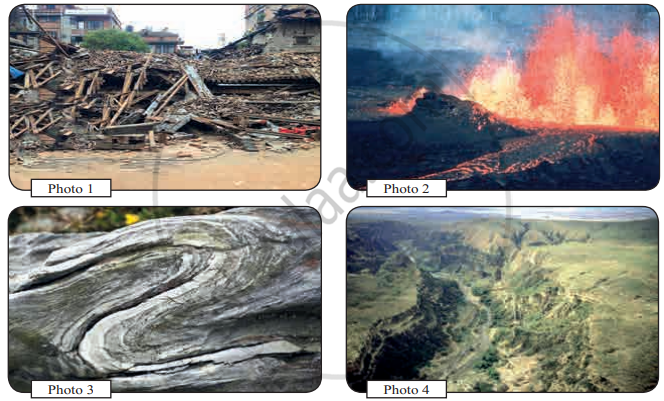
- What might be the reasons behind buildings collapsing in photo 1?
- Which event is depicted in photo 2? What impact does it bring about in the surroundings?
- In photo 3, what could be the reason behind the bend in the rock strata?
- What could be the reason behind the difference in altitudes of the land and the steepness of the slope in photo 4?
- Classify the events in the photos into sudden and slow movements.
- Example of which of these movements is not likely to be found in the mainland of the Indian sub-continent?
On 19th August 2018, around 300 people died in Indonesia. Many buildings collapsed. Many roads broke apart. A tsunami was generated.
- What was the cause behind these events?
- What actually happened during this natural event?
- Name the energy waves involved in this natural event.
- Observe the diagram and label the boxes.
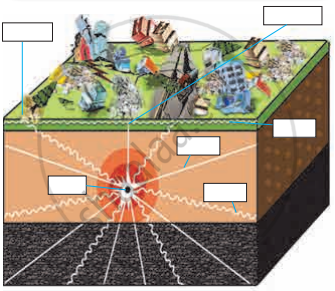
Balbharati solutions for Geography (Social Science) [English] 11 Standard 1 Earth Movements Think about it. [Pages 3 - 7]
How will compressional forces affect brittle rocks?
'A mountain never remains a mountain'. Can you relate this idiom with the mountain building process?
When can faults form in fold mountains?
Can folds form in block mountains? Find the reasons and discuss.
Look at figure During an earthquake, do you think the seismic waves reach entire portion of the earth? Is there any region on the Earth's surface where a given earthquake will not be reported?

Shadow zone of an earthquake
Why has a shadow zone for L-waves not been shown in the figure?

Shadow zone of an earthquake
Balbharati solutions for Geography (Social Science) [English] 11 Standard 1 Earth Movements Try this. [Pages 4 - 5]
Observe the following diagrams. Try to understand the different types of fold shown in the diagram and match it with its characteristics. Write the name of the fold in the space given below.

A) Symmetrical:
- The axial plane is vertical.
- Limbs are inclined at same angle.
B) Asymmetrical:
- The axial plane is inclined.
- The limbs are inclined at different angles.
C) Overturned:
- One limb lies above the other limb.
- Limbs slope unequally in the same direction.
D) Recumbent:
- The axial plane is almost horizontal.
- One limb lies over the other in a horizontal direction.
E) Isoclinal:
- The limbs slope in the same direction with the same amount.
- The axial plane may be vertical, inclined, or horizontal.
- The slope of some portion of limbs is near vertical.
Observe the diagrams and read the explanation regarding the characteristics of various faults given below. Identify the faults and match each of them with their characteristics.

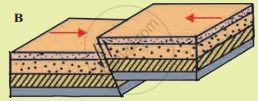
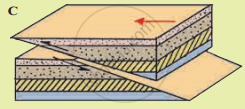

A) Normal fault: It results when a portion of land slides down along the fault plane and when the exposed portion of the plane faces the sky.
B) Reverse fault: It results when a portion of the land is thrown upward relative to other side of the land. In such situation, the fault plane faces the ground.
C) Tear fault: At times, the rock strata on either sides of the fault plane do not have vertical displacement. Instead, movement occurs along the plane in horizontal direction.
D) Thrust fault: When the portion of the land on one side of the fault plane gets detached and moves over land on the other side. The angle of fault plane is generally lowless than 45°.
Balbharati solutions for Geography (Social Science) [English] 11 Standard 1 Earth Movements Can you tell? [Page 7]
In Figures A, B, C is three points on the earth's surface. Analyse their locations with respect to epicenter and shadow zones

Balbharati solutions for Geography (Social Science) [English] 11 Standard 1 Earth Movements Give it a try. [Page 8]
How to locate epicentre of a given earthquake?
Take the given hypothetical data in the table. The data shows the time of arrival of P-waves and S-waves at 3 seismograph stations. Assume the scale of the map as 1 cm: 18 km. See figure.
| Recording Station | P-wave arrival time ( IST) | S-wave arrival time |
| Jalana | 11: 06: 06 | 11: 06: 19 |
| Washim | 11: 06: 46 | 11: 07: 03 |
| Aurangabad | 11: 07: 06 | 11: 07: 24 |
Procedure :
- Compute the time difference between the arrival of P-waves and S-waves for each station; this is called time lag. (It shows the distance of the seismograph from the focus. Thumb rule: For every second of time lag, the earthquake is approximately 8 km away.)
- Using the rule above, convert the time lag into the distance (seconds of time lag × 8) for each station.
- Convert this distance into centimetres as per the scale of the map.
- On a map, locate the seismograph stations.
- Draw circles, taking the seismograph stations as the centre, with the radius equal to the distance you have calculated in the previous step.
- These arcs of circles will intersect one another at a point. This point is the location of the epicentre.
In normal practice, an epicentre is located using computer models. The procedure outlined here is a much simplified version of what is normally done, although the principle is the same.
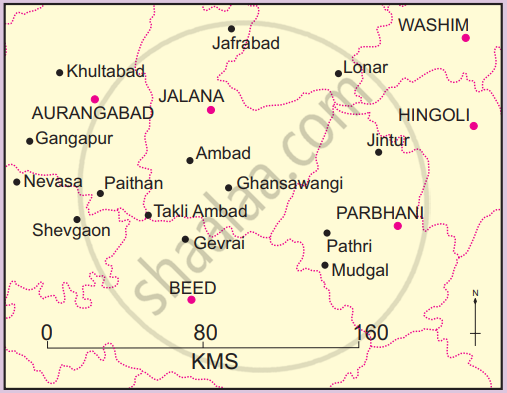
Balbharati solutions for Geography (Social Science) [English] 11 Standard 1 Earth Movements Find out ! [Page 9]
Find out examples of active, dormant and extinct volcanoes.
Balbharati solutions for Geography (Social Science) [English] 11 Standard 1 Earth Movements Exercise [Pages 13 - 14]
Complete the chain:
| A | B | C |
| 1) Widespread volcanic eruption | 1) Zone V | 1) I to XII |
| 2) Andaman and Nicobar Islands | 2) Fissure eruption | 2) Block Mountain |
| 3) Mercalli scale | 3) Intensity | 3) Very high seismic vulnerability |
| 4) Slow movements | 4) Faulting | 4) Solid |
| 5) Phillippines | 5) Volcanic bombs | 5) Deccan Trap |
| 6) Volcanic material | 6) Circum Pacific belt | 6) Mayon |
Identify the correct correlation:
A: Assertion; R: Reasoning
A: Faulting leads to the development of fold mountains.
R: Faulting occurs when tensional forces move away from each other.
Only A is correct
Only R is correct
Both A and R are correct and R is the correct explanation of A.
Both A and R are correct but R is not the correct explanation of A.
Assertion A: Intensity of an earthquake is a measurement of the energy released during an earthquake.
Reasoning R: Mercallis scale is used to measure the intensity of an earthquake.
Only A is correct
Only R is correct
Both A and R are correct and R is the correct explanation of A.
Both A and R are correct but R is not the correct explanation of A.
Identify the correct correlation:
A: Assertion; R: Reasoning
A: South-East Asia, Japan, and islands in the Pacific Ocean are most vulnerable to earthquakes and volcanic eruptions.
R: They are located in the 'Ring of Fire'.
Only A is correct
Only R is correct
Both A and R are correct and R is the correct explanation of A
Both A and R are correct but R is not the correct explanation of A.
Identify the correct group:
- Symmetrical fold
- Isoclinal fold
- Overturned fold
- Recumbent fault
- Black Forest
- Vosges
- Himalayas
- Satpuras
- Narmada Valley
- African Valley
- Tapi Valley
- Rhine Valley
- Caldera
- Crater lake
- Cinder Cone
- Lava plateau
Give a geographical reason:
Extinct conical volcanoes often form crater lakes.
Give a geographical reason:
People living in the Himalayas are more vulnerable to earthquakes.
Give a geographical reason:
L-waves do not have a shadow zone.
Give a geographical reason:
Soft rocks form folds while hard rocks form faults.
Give a geographical reason:
Folds depend on the strength of rocks and the intensity of forces.
Answer in detail:
Explain different types of faults.
Answer in detail:
Explain with examples, different types of landforms produced by a volcanic eruption.
Answer in detail:
Explain the concept of the shadow zone.
Answer in detail:
Write a note on volcanic materials
Differentiate between Folding and faulting.
Differentiate between Normal fault and Reverse fault
Differentiate between Syncline and Anticline
Differentiate between Asymmetrical fold and Symmetrical fold
Differentiate between Mercalli scale and Richter scale
Differentiate between Slow movements and sudden movements
Draw diagram of Types of folds
Draw a diagram of the Types of faults.
Draw diagram of Shadow zone
Draw diagram for Volcanic landforms.
Solutions for 1: Earth Movements
![Balbharati solutions for Geography (Social Science) [English] 11 Standard chapter 1 - Earth Movements Balbharati solutions for Geography (Social Science) [English] 11 Standard chapter 1 - Earth Movements - Shaalaa.com](/images/geography-social-science-english-11-standard_6:acdc1b8f00d74d0085a22ac1e29ad6d2.jpg)
Balbharati solutions for Geography (Social Science) [English] 11 Standard chapter 1 - Earth Movements
Shaalaa.com has the Maharashtra State Board Mathematics Geography (Social Science) [English] 11 Standard Maharashtra State Board solutions in a manner that help students grasp basic concepts better and faster. The detailed, step-by-step solutions will help you understand the concepts better and clarify any confusion. Balbharati solutions for Mathematics Geography (Social Science) [English] 11 Standard Maharashtra State Board 1 (Earth Movements) include all questions with answers and detailed explanations. This will clear students' doubts about questions and improve their application skills while preparing for board exams.
Further, we at Shaalaa.com provide such solutions so students can prepare for written exams. Balbharati textbook solutions can be a core help for self-study and provide excellent self-help guidance for students.
Concepts covered in Geography (Social Science) [English] 11 Standard chapter 1 Earth Movements are Earth Movements, Evidences of Earth Movements, Slow Earth's Movements, Folding, Faulting, Sudden Movements, Earthquake, Shadow Zone of an Earthquake, Volcanoes, Volcanic Materials, Volcanic Landforms, Earthquake Zones of the World, Distribution of Volcanoes in the World.
Using Balbharati Geography (Social Science) [English] 11 Standard solutions Earth Movements exercise by students is an easy way to prepare for the exams, as they involve solutions arranged chapter-wise and also page-wise. The questions involved in Balbharati Solutions are essential questions that can be asked in the final exam. Maximum Maharashtra State Board Geography (Social Science) [English] 11 Standard students prefer Balbharati Textbook Solutions to score more in exams.
Get the free view of Chapter 1, Earth Movements Geography (Social Science) [English] 11 Standard additional questions for Mathematics Geography (Social Science) [English] 11 Standard Maharashtra State Board, and you can use Shaalaa.com to keep it handy for your exam preparation.
